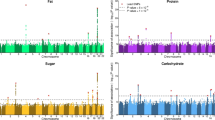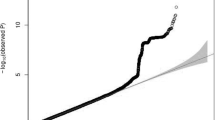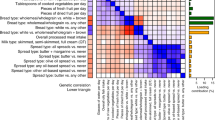Abstract
Prior research identified genetic variants influencing macronutrient preference, but whether genetic differences underlying nutrient preference affect long-term food choices is unknown. Here we examined the associations of polygenic scores for carbohydrate, fat, and protein preference with 12 months’ workplace food purchases among 397 hospital employees from the ChooseWell 365 study. Food purchases were obtained retrospectively from the hospital’s cafeteria sales data for the 12 months before participants were enrolled in the ChooseWell 365 study. Traffic light labels, visible to employees when making purchases, measured the quality of workplace purchases. During the 12-month study period, there were 215,692 cafeteria purchases. Each SD increase in the polygenic score for carbohydrate preference was associated with 2.3 additional purchases/month (95%CI, 0.2 to 4.3; p = 0.03) and a higher number of green-labeled purchases (β = 1.9, 95%CI, 0.5–3.3; p = 0.01). These associations were consistent in subgroup and sensitivity analyses accounting for additional sources of bias. There was no evidence of associations between fat and protein polygenic scores and cafeteria purchases. Findings from this study suggest that genetic differences in carbohydrate preference could influence long-term workplace food purchases and may inform follow-up experiments to enhance our understanding of the molecular mechanisms underlying food choice behavior.
This is a preview of subscription content, access via your institution
Access options
Subscribe to this journal
Receive 12 print issues and online access
$259.00 per year
only $21.58 per issue
Buy this article
- Purchase on Springer Link
- Instant access to full article PDF
Prices may be subject to local taxes which are calculated during checkout

Similar content being viewed by others
Data availability
Data described in the paper will be made available upon request, pending application and approval.
Code availability
Code to reproduce analyses for this paper will be made available upon publication on GitHub.
References
Zuker CS. Food for the brain. Cell 2015;161:9–11.
Tan HE, Sisti AC, Jin H, Vignovich M, Villavicencio M, Tsang KS, et al. The gut–brain axis mediates sugar preference. Nature 2020;580:511–6.
Li M, Tan HE, Lu Z, Tsang KS, Chung AJ, Zuker CS. Gut-brain circuits for fat preference. Nature 2022;610:722–30.
Goldstein N, McKnight AD, Carty JRE, Arnold M, Betley JN, Alhadeff AL. Hypothalamic detection of macronutrients via multiple gut-brain pathways. Cell Metab. 2021;33:676–87.
Atasoy D, Betley JN, Su HH, Sternson SM. Deconstruction of a neural circuit for hunger. Nature 2012;488:172–7.
Small DM, DiFeliceantonio AG. Processed foods and food reward. Sci (1979) 2019;363:346–7.
DiFeliceantonio AG, Coppin G, Rigoux L, Edwin Thanarajah S, Dagher A, Tittgemeyer M, et al. Supra-Additive Effects of Combining Fat and Carbohydrate on Food Reward. Cell Metab. 2018;28:33–44.e3.
van der Klaauw AA, Farooqi IS. The Hunger Genes: Pathways to Obesity. Cell 2015;161:119–32.
van der Klaauw AA, Keogh JM, Henning E, Stephenson C, Kelway S, Trowse VM, et al. Divergent effects of central melanocortin signalling on fat and sucrose preference in humans. Nat Commun. 2016;7:13055.
Cecil JE, Tavendale R, Watt P, Hetherington MM, Palmer CNA. An obesity-associated FTO gene variant and increased energy intake in children. N Engl J Med. 2008;359:2558–66.
Ranzenhof L. The FTO gene and measured food intake in 5-10 year old children who are not obese. Obesity 2019;27:1023–9.
Tanofsky-Kraff M, Han JC, Anandalingam K, Shomaker LB, Columbo KM, Wolkoff LE, et al. The FTO gene rs9939609 obesity-risk allele and loss of control over eating. Am J Clin Nutr. 2009;90:1483–8.
Chu AY, Workalemahu T, Paynter NP, Rose LM, Giulianini F, Tanaka T, et al. Novel locus including FGF21 is associated with dietary macronutrient intake. Hum Mol Genet. 2013;22:1895–902.
Merino J, Dashti HS, Sarnowski C, Lane JM, Todorov PV, Udler MS, et al. Genetic analysis of dietary intake identifies new loci and functional links with metabolic traits. Nat Hum Behav. 2022;6:155–63.
Merino J, Dashti HS, Li SX, Sarnowski C, Justice AE, Graff M, et al. Genome-wide Meta-Analysis of Macronutrient Intake of 91,116 European Ancestry Participants Identifies from the Cohorts for Heart and Aging Research in Genomic Epidemiology Consortium. Mol Psychiatry 2019;24:1920–32.
Tanaka T, Ngwa JS, van Rooij FJA, Zillikens MC, Wojczynski MK, Frazier-Wood AC, et al. Genome-wide meta-analysis of observational studies shows common genetic variants associated with macronutrient intake. Am J Clin Nutr. 2013;97:1395–402.
Meddens SFW, de Vlaming R, Bowers P, Burik CAP, Linnér RK, Lee C, et al. Genomic analysis of diet composition finds novel loci and associations with health and lifestyle. Mol Psychiatry 2021;26:2056–2069.
Levy DE, Gelsomin ED, Rimm EB, Pachucki M, Sanford J, Anderson E, et al. Design of ChooseWell 365: Randomized controlled trial of an automated, personalized worksite intervention to promote healthy food choices and prevent weight gain. Contemp Clin Trials. 2018;75:78–86.
Thorndike AN, Sonnenberg L, Riis J, Barraclough S, Levy DE. A 2-phase labeling and choice architecture intervention to improve healthy food and beverage choices. Am J Public Health. 2012;102:527–33.
McCurley JL, Levy DE, Rimm EB, Gelsomin ED, Anderson EM, Sanford JM, et al. Association of Worksite Food Purchases and Employees’ Overall Dietary Quality and Health. Am J Prev Med. 2019;57:87–94.
McCarthy S, Das S, Kretzschmar W, Delaneau O, Wood AR, Teumer A, et al. A reference panel of 64,976 haplotypes for genotype imputation. Nat Genet. 2016;48:1279–83.
Loh PR, Danecek P, Palamara PF, Fuchsberger C, Reshef YA, Finucane HK, et al. Reference-based phasing using the Haplotype Reference Consortium panel. Nat Genet. 2016;48:1443–8.
Hagströmer M, Oja P, Sjöström M. The International Physical Activity Questionnaire (IPAQ): a study of concurrent and construct validity. Public Health Nutr. 2006;9:755–62.
Wang C, Zhan X, Liang L, Abecasis GR, Lin X. Improved Ancestry Estimation for both Genotyping and Sequencing Data using Projection Procrustes Analysis and Genotype Imputation. Am J Hum Genet. 2015;96:926–37.
Schielzeth H, Dingemanse NJ, Nakagawa S, Westneat DF, Allegue H, Teplitsky C, et al. Robustness of linear mixed-effects models to violations of distributional assumptions. Methods Ecol Evol. 2020;11:1141–52.
Pirastu N, McDonnell C, Grzeszkowiak EJ, Mounier N, Imamura F, Merino J, et al. Using genetic variation to disentangle the complex relationship between food intake and health outcomes. PLoS Genet. 2022;18:e1010162.
Stolwijk AM, Straatman H, Zielhuis GA. Studying seasonality by using sine and cosine functions in regression analysis. J Epidemiol Commun Health 1999;53:235–8.
Fewell Z, Davey Smith G, Sterne JAC. The impact of residual and unmeasured confounding in epidemiologic studies: A simulation study. Am J Epidemiol. 2007;166:646–55.
Vanderweele TJ. Epidemiologic Methods Sample Size and Power Calculations for Additive Interactions Sample Size and Power Calculations for Additive Interactions. Epidemiol Methods. 2012;1:159–88.
van der Klaauw A, Keogh J, Henning E, Stephenson C, Trowse VM, Fletcher P, et al. Role of melanocortin signalling in the preference for dietary macronutrients in human beings. Lancet 2015;385:S12.
Urban-Ciecko J, Barth AL. Somatostatin-expressing neurons in cortical networks. Nat Rev Neurosci. 2016;17:401–9.
Jensen-Cody SO, Flippo KH, Claflin KE, Yavuz Y, Sapouckey SA, Walters GC, et al. FGF21 Signals to Glutamatergic Neurons in the Ventromedial Hypothalamus to Suppress Carbohydrate Intake. Cell Metab. 2020;32:273–86.
Dashti HS, Hivert MF, Levy DE, McCurley JL, Saxena R, Thorndike AN. Polygenic risk score for obesity and the quality, quantity, and timing of workplace food purchases: A secondary analysis from the ChooseWell 365 randomized trial. PLoS Med. 2020;17:31003219.
Joslin AC, Sobreira DR, Hansen GT, Sakabe NJ, Aneas I, Montefiori LE, et al. A functional genomics pipeline identifies pleiotropy and cross-tissue effects within obesity-associated GWAS loci. Nat Commun. 2021;12:5253.
Boyle EA, Li YI, Pritchard JK. An Expanded View of Complex Traits: From Polygenic to Omnigenic. Cell 2017;169:1177–86.
Murray CJL, Atkinson C, Bhalla K, Birbeck G, Burstein R, Chou D, et al. The state of US health, 1990-2010: burden of diseases, injuries, and risk factors. JAMA 2013;310:591–608.
Rodgers A, Woodward A, Swinburn B, Dietz WH. Prevalence trends tell us what did not precipitate the US obesity epidemic. Lancet Public Health 2018;3:e162–e163.
Lichtenstein AH, Appel LJ, Vadiveloo M, Hu FB, Kris-Etherton PM, Rebholz CM, et al. 2021 Dietary Guidance to Improve Cardiovascular Health: A Scientific Statement From the American Heart Association. Circulation 2021;144:e472–e487.
Thorndike AN, Gelsomin ED, McCurley JL, Levy DE. Calories Purchased by Hospital Employees After Implementation of a Cafeteria Traffic Light–Labeling and Choice Architecture Program. JAMA Netw Open 2019;2:e196789.
Thorndike AN, Riis J, Levy DE. Social norms and financial incentives to promote employees’ healthy food choices: A randomized controlled trial. Prev Med (Balt). 2016;86:12–8.
Acknowledgements
We would like to thank the participants and staff of the ChooseWell 365 study. JM is supported by the American Diabetes Association (7-21-JDFM-005), the Nutrition Obesity Research Center at Harvard (P30 DK040561), and the NIH UG1 HD107691. HSD and RS are supported by NIH R01 DK105072 and DK107859. RS is also supported by NIH R01 DK102696 and MGH Research Scholar Fund. The ChooseWell 365 clinical trial was supported by NIH R01HL125486, R01DK114735, and 1UL1TR001102. We thank Emily D. Gelsomin, MLA, RD, LDN, Department of Nutrition and Food Services, Massachusetts General Hospital, for critical help with nutritional profiling. The funders had no role in study design, data collection, analysis, publication decision, or paper preparation.
Author information
Authors and Affiliations
Contributions
JM, DEL, and ANT conceived and designed the study. DEL and ANT oversaw the study. JM and BCP conducted the data analysis. All authors contributed to and critically reviewed the paper and approved the final version of the paper.
Corresponding authors
Ethics declarations
Competing interests
The authors declare no competing interests.
Additional information
Publisher’s note Springer Nature remains neutral with regard to jurisdictional claims in published maps and institutional affiliations.
Supplementary information
Rights and permissions
Springer Nature or its licensor (e.g. a society or other partner) holds exclusive rights to this article under a publishing agreement with the author(s) or other rightsholder(s); author self-archiving of the accepted manuscript version of this article is solely governed by the terms of such publishing agreement and applicable law.
About this article
Cite this article
Merino, J., Dashti, H.S., Levy, D.E. et al. Genetic predisposition to macronutrient preference and workplace food choices. Mol Psychiatry 28, 2606–2611 (2023). https://doi.org/10.1038/s41380-023-02107-x
Received:
Revised:
Accepted:
Published:
Issue Date:
DOI: https://doi.org/10.1038/s41380-023-02107-x



